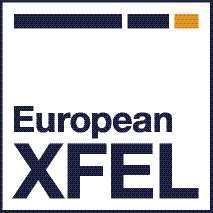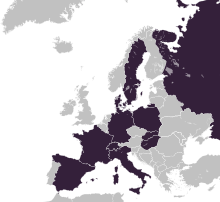European XFEL
Coordinates: 53°35′20″N 9°49′44″E / 53.589°N 9.829°E
 | |
| Fundamental research | |
| Founded | 23 September 2009[1] |
| Headquarters | Schenefeld, Germany |
| Website |
www |

The European X-Ray Free-Electron Laser Facility (European XFEL) is an X-ray research laser facility commissioned during 2017. The first laser pulses were produced in May 2017[2][3] and the facility started user operation in September 2017.[4] The international project with twelve participating countries; nine shareholders (Denmark, France, Germany, Hungary, Poland, Russia, Slovakia, Sweden and Switzerland) and three other partners (Italy, Spain and the United Kingdom)[5][6] is located in the German federal states of Hamburg and Schleswig-Holstein.[7] A free-electron laser generates high-intensity electromagnetic radiation by accelerating electrons to relativistic speeds and directing them through special magnetic structures. The European XFEL is constructed such that the electrons produce X-ray light in synchronisation, resulting in high-intensity X-ray pulses with the properties of laser light and at intensities much brighter than those produced by conventional synchrotron light sources.
Location
The 3.4-kilometre (2.1 mi) long tunnel for the European XFEL housing the superconducting linear accelerator and photon beamlines runs 6 to 38 m (20 to 125 ft) underground from the site of the DESY research center in Hamburg to the town of Schenefeld in Schleswig-Holstein, where the experimental stations, laboratories and administrative buildings are located.[8]
Accelerator
Electrons are accelerated to an energy of up to 17.5 GeV by a 2.1 km (1.3 mi) long linear accelerator with superconducting RF-cavities.[8] The use of superconducting acceleration elements developed at DESY allows up to 27,000 repetitions per second, significantly more than other X-ray lasers in the U.S. and Japan can achieve.[9] The electrons are then introduced into the magnetic fields of special arrays of magnets called undulators, where they follow curved trajectories resulting in the emission of X-rays whose wavelength is in the range of 0.05 to 4.7 nm.[8]
Laser
The X-rays are generated by self-amplified spontaneous emission (SASE), where electrons interact with the radiation that they or their neighbours emit. Since it is not possible to build mirrors to reflect the X-rays for multiple passes through the electron beam gain medium, as with light lasers, the X-rays are generated in a single pass through the beam. The result is spontaneous emission of X-ray photons which are coherent (in phase) like laser light, unlike X-rays emitted by ordinary sources like X-ray machines, which are incoherent. The peak brilliance of the European XFEL is billions of times higher than that of conventional X-ray light sources, while the average brilliance is 10,000 times higher.[8] The higher electron energy allows the production of shorter wavelengths.[9] The duration of the light pulses can be less than 100 femtoseconds.[8]
Research
The short laser pulses make it possible to measure chemical reactions that are too rapid to be captured by other methods. The wavelength of the X-ray laser may be varied from 0.05 to 4.7 nm, enabling measurements at the atomic length scale.[8]
Initially, one photon beamline with two experimental stations can be used.[8] Later this will be upgraded to five photon beamlines and a total of ten experimental stations.[10]
The experimental beamlines enable unique scientific experiments using the high intensity, coherence and time structure of the new source to be conducted in a variety of disciplines spanning physics, chemistry, materials science, biology and nanotechnology.[11]
History

The German Federal Ministry of Education and Research granted permission to build the facility on 5 June 2007 at a cost of €850 million, under the provision that it should be financed as a European project.[12] The European XFEL GmbH that built and operates the facility was founded in 2009.[13] Civil construction of the facility began on 8 January 2009. Construction of the tunnels was completed in summer 2012,[14] and all underground construction was completed the following year.[15] The first beams were accelerated in April 2017, and the first X-ray beams were produced in May 2017.[2][3] XFEL was inaugurated in September 2017.[4] The overall cost for the construction and commissioning of the facility is as of 2017 estimated at €1.22 billion (price levels of 2005).[8]
References
- ↑ "HRB 111165: The European XFEL GmbH has been founded!". 13 October 2009. Retrieved 17 July 2018.
- 1 2 "World's biggest ever X-ray laser shines its first light". 4 May 2017. Retrieved 4 May 2017.
- 1 2 "Größter Röntgenlaser der Welt erzeugt erstes Laserlicht" (in German). 4 May 2017. Retrieved 4 May 2017.
- 1 2 "International X-ray laser European XFEL inaugurated". 1 September 2017. Retrieved 2 September 2017.
- ↑ "European XFEL - Organization - Company - Shareholders". www.xfel.eu. Retrieved 28 May 2017.
- ↑ Massimo Altarelli, ed. (2014). Annual Report of 2014 (PDF). European X-ray Free-Electron Laser Facility Gmbh. p. 10.
- ↑ "DESY's European XFEL project group". Retrieved 20 December 2007.
- 1 2 3 4 5 6 7 8 "European XFEL facts & figures". Retrieved 2 September 2017.
- 1 2 "European XFEL in comparison". Retrieved 4 May 2017.
- ↑ "How it works". Retrieved 4 September 2017.
- ↑ "Science". Retrieved 4 September 2017.
- ↑ "Launch of the European XFEL".
- ↑ European XFEL news: "HRB 111165: The European XFEL GmbH has been founded!"
- ↑ European XFEL news: "Tunnel construction completed"
- ↑ European XFEL news: "European XFEL underground construction completed"
External links
| Wikimedia Commons has media related to European XFEL. |